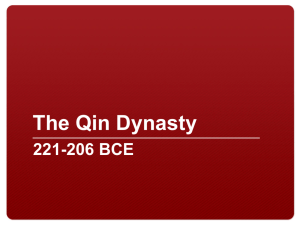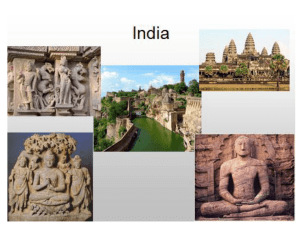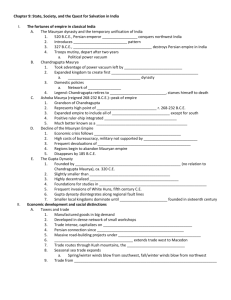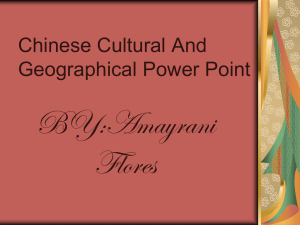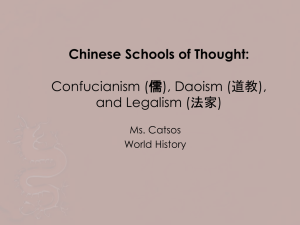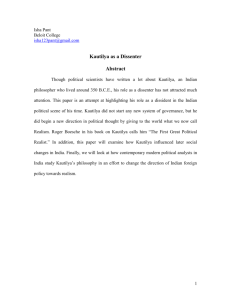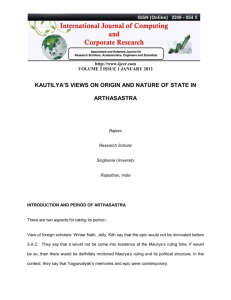Muscat REALISM AND TOTALITARIANISM IN ANCIENT EAST ASIA
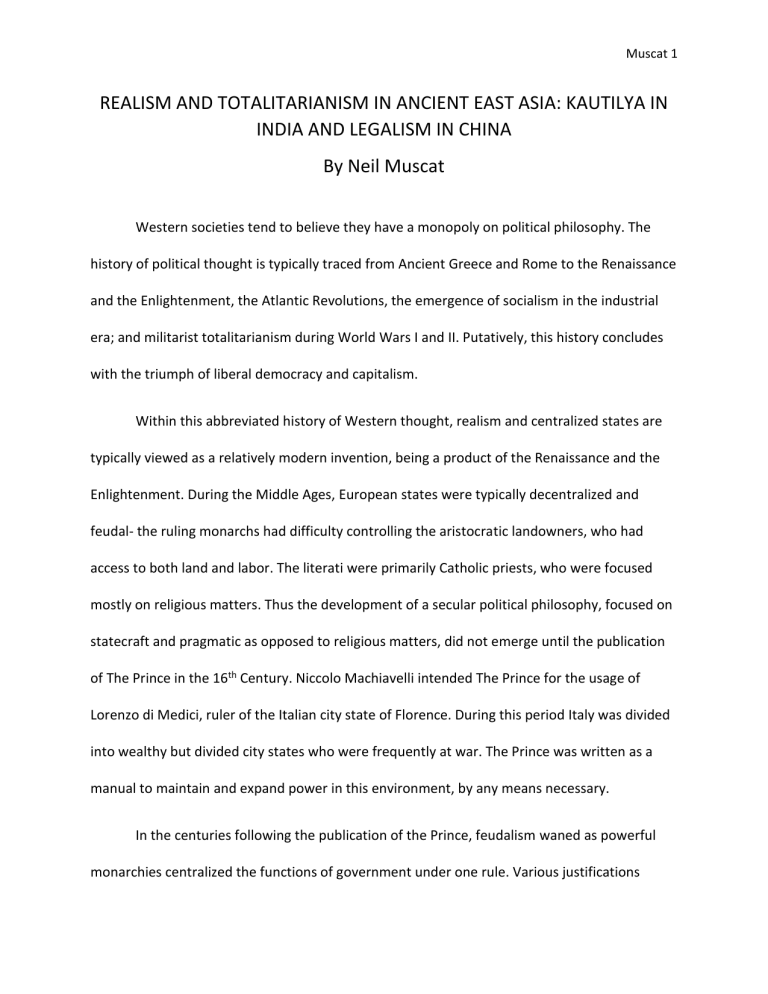
Muscat 1
REALISM AND TOTALITARIANISM IN ANCIENT EAST ASIA: KAUTILYA IN
INDIA AND LEGALISM IN CHINA
By Neil Muscat
Western societies tend to believe they have a monopoly on political philosophy. The history of political thought is typically traced from Ancient Greece and Rome to the Renaissance and the Enlightenment, the Atlantic Revolutions, the emergence of socialism in the industrial era; and militarist totalitarianism during World Wars I and II. Putatively, this history concludes with the triumph of liberal democracy and capitalism.
Within this abbreviated history of Western thought, realism and centralized states are typically viewed as a relatively modern invention, being a product of the Renaissance and the
Enlightenment. During the Middle Ages, European states were typically decentralized and feudal- the ruling monarchs had difficulty controlling the aristocratic landowners, who had access to both land and labor. The literati were primarily Catholic priests, who were focused mostly on religious matters. Thus the development of a secular political philosophy, focused on statecraft and pragmatic as opposed to religious matters, did not emerge until the publication of The Prince in the 16 th Century. Niccolo Machiavelli intended The Prince for the usage of
Lorenzo di Medici, ruler of the Italian city state of Florence. During this period Italy was divided into wealthy but divided city states who were frequently at war. The Prince was written as a manual to maintain and expand power in this environment, by any means necessary.
In the centuries following the publication of the Prince, feudalism waned as powerful monarchies centralized the functions of government under one rule. Various justifications
Muscat 2 emerged for absolute monarchs- both religious (the divine right of kings) and secular (Thomas
Hobbes formulation of an authoritarian social contract). By World War I, absolute monarchy had collapsed, and the totalitarian states of Nazi Germany and the Soviet Union emerged shortly afterwards. These states were based on the total centralization of power, government control over every aspect of life, and the maintenance of power by widespread societal surveillance and spying.
These political trends and ideas- the realist pursuit of power, a powerful monarchy presiding over a centralized bureaucracy, a government with absolute and complete power over society- which appeared in the West only during the modern era, were in fact precluded by Asian thinkers by nearly two thousand years. Centuries before the birth of Christ, there were a plethora of realists in both India and China who managed to put their political philosophies into practice- namely, Kautilya, de facto Prime Minister of the Mauryan Empire, and the
Legalists of the Chinese Warring States from which emerged the Qin Dynasty. These realists completely disdained traditional morality; and advocated mass murder, trickery, and dishonesty. They sought to promote the power of the states they served without any restraint or compunction. Unlike many of their contemporaries, who were philosophers with a religious or spiritual bent; the realists of East Asia used their philosophy as a weapon and a tool. They were often powerful politicians seeking the patronage of a King or Emperor. In both India and
China, the realists and the monarchs they served created centralized empires which dominated the core of their contemporary successor states. Both the Mauryan Empire and the Qin Dynasty were relatively short-lived- the Qin Dynasty lasted a scant fourteen years, and the Mauryan
Empire lasted a little longer than a century. However, in China the Qin Dynasty resulted in a
Muscat 3 semi-permanent Chinese nation-state, while the Mauryan Empire failed to create a united
Indian identity.
The Arthashastra: The Mauryan Empire and Kautilya
Kautilya, also known as Chanayka, was a Brahmin who became the senior adviser to the first Mauryan Emperor, Chandragupta. Before Chandragupta, the dominant political entity in
India was the Nanda Empire, but the Nanda kings were unpopular and tyrannical. The invasion of Alexander the Great and the Greeks from the West in 326 B.C disrupted the Indian political scene. Chandragupta, at the time a youth, was able to rally support against the Greeks, and then used the power and prestige gained from this effort to overthrow the Nanda kings, establishing a state that would control most of the Indian subcontinent. Kautilya became
Chandragupta’s mentor, and wrote the Arthashastra as a manual for his sovereign regarding the art of ruling. The similarities with The Prince prompted sociologist Max Weber to make the comparison between the two works, however he considered Machiavelli “harmless” in contrast.
1 The Arthashastra, however, was broader in scope than the Prince, seeking to establish rules on society as a whole. The Arthashastra can be considered the first major book on political science and economics in history.
At the heart of The Arthashastra lies a pragmatic amorality and tendency to absolute dictatorship. Kautilya did not believe in an absence of restraints- he recommended that kings be trained to control their baser passions such as lust and gluttony. He prescribed an intense education and schedule for hypothetical rulers’ suggesting that to prevent chaos a ruler must
1 Boesche, 2002, Pages 1-19. Historical Background.
Muscat 4 not only be strong but self-disciplined, fully dedicated to maintaining the kingdom without weakness or scruples. A ruler must even be willing to kill members of his own family for the good of the kingdom, especially princes so immature that their passions would prevent them from ruling. The goal of the ruler should be to “destroy enemies and protect his people.”
Kautilya did not advocate total oppression and disdain for human rights, but mostly for pragmatic reasons- he noted that implementing “social justice” for the people was often in the interest of the king. 2
The most unique aspect of the Arthashastra is the focus on spying, surveillance, and assassinations to defeat the internal and external enemies of the state (though the Chinese legalists also believed in extensive intelligence gathering to sustain the government.) Kautilya, in great detail, proposed a surveillance state that was remarkably extensive for an empire with only Iron Age technology; and presaged the totalitarian surveillance states of the 20 th century by more than two thousand years. Public meetings and organizations outside government control were to be banned. Spies were to tempt bureaucrats and officials with attempted treason in order to prevent rebellion and root out enemies of the ruler. Kautilya provided an extensive list of people to be recruiting as spies- including orphans, widows, priests, prostitutes, entertainers, ascetics/beggars, dwarves, eunuchs, the disabled, traders or “wandering people” to surveil lower castes and commoners. Orphans, notably, who were already wards of the state, were to be trained as spies (this implies the existence of a welfare state).
3 The power and surveillance of the state was to extend to every level of society, and was to be supplemented
2 Boesche, 2002, Pages 19-44. A Science of Politics.
3 Arthashastra, 1915, Page 15.
Muscat 5 with both torture and frequent arrests of the suspicious. Kautilya’s proposed policies were so totalitarian that he called for the regulation of sex and daily chores of all the common people.
4 Against the enemies of the state, Kautilya provided extensive rules for assassinations, typically by poison and deceit, seemingly preferring manipulation and trickery to the application of brute force. It’s not clear if Mauryan Empire had the capability to even partially implement such a regime, Kautilya is describing an ideal that did not come to fruition until the modern era.
Kautilya’s powerful monarchy also extended into economic matters. Kautilya was also a pioneer in political economy, as can be seen in the title Arthashastra- the term artha translating into wealth or money. Many other ancient political scientists placed emphasis on a powerful army; Kautilya believed in the power of the treasury. A strong treasury ensured material prosperity and a monetary basis for state power. Kautilya advocated policies that today would be considered socialist- government ownership of land and national industries, heavy taxation, government control of agriculture, and a paternalist welfare state.
5 The power of the state could be used to promote the general welfare and ensure the success of various national industries. Despite his focus on materialism, Kautilya retained a traditional mistrust of merchants as greedy and self-interested. Kautilya’s materialism was of a nationalist character.
(The Chinese legalists held similar views to Kautilya in terms of government ownership, however their economic proposals were less developed.)
Kautilya also advocated a ruthless, realist foreign policy, which would be classified in modern times as offensive realism- that the state should maximize power and destroy its
4 Boesche, 2002, Pages 45-64. Kautilya’s Spy State.
5 Boesche, 2002, Pages 65-75. A Socialist Monarchy.
Muscat 6 enemies. This foreign policy was applied by the Mauryan Empire to eliminate competing states and unify India, their goal seeming to be maximum conquest. As in domestic affairs, the
Arthashastra called for assassinations and deceit to undermine enemies of the King; though the
Mauryan Empire certainly did not fear open warfare. Kautilya’s most significant contribution to foreign policy was the idea of the mandala system of neighboring states, comparing political geography to a wheel. While bordering states should be considered enemies, the states beyond them should be considered allies- alliances alternating based on geography. Kautilya called for only temporary alliances and peace treaties, and called for a ruler to attack enemies when these enemies were ruled by weak kings or facing rebellion. A state should focus on these states one at a time in order to minimize the costs of war.
6
The Chinese Legalists: Han Fei, Shang Yang, and the Qin Dynasty
Legalism, or 法家 (F ǎ Ji ā ) was term retroactively applied by the historian Sima Qian to describe a group of thinkers from the warring states period. The legalists were not a unified group or school, but rather philosophers with interlinking ideas. Questions regarding government, morality, and society emerged during the warring states period as seven states frequently battled for control of China, resulting in mass devastation and war. Various philosophies emerged from this period- Confucianism, Daoism and Mohism- to confront the challenges created from such upheaval. Legalism both drew from and opposed these schools.
The first legalist, Guan Zhong, became Prime Minister of the Qi state in 685 B.C. The later legalists Li Kui and Wu Qi were associated with the Wei kingdom around 400 B.C. However, the
6 Boesche, 2002, Pages 77-94. Foreign Policy and War.
Muscat 7 most prominent legalists, Shang Yang and Li Si became officials of the Qin Kingdom, which fully realized the implications of legalism and unified China under Qin Shi Huangdi in 221 B.C. (Han
Fei, the most comprehensive legalist theorist, eventually became a minister of Qin, but was seen as a threat by Li Si and was executed.) 7
Like Kautilya, the legalists were realists and ruthlessly pragmatic. The Legalists explicitly rejected Confucian views on the duties and responsibilities of a ruler to his people. Power was both a means and an ultimate end. Subjects of the ruler were his tools and possessions, and were explicitly compared to sheep. Additionally, the Legalists view people as inherently evil, selfish, and untrustworthy. Without a strong hand to guide the people, society would degenerate into chaos and disorder. A powerful state was thus seen as necessary to sustain a healthy society and maintain order, but also to serve the self-interest of the ruler. Politics was seen as a constant struggle against other humans; establishing oneself as an absolute monarch was seen as victory. The power of the state was supreme and all encompassing. Thus the legalists provided the first comprehensive defense of totalitarianism. 8
A distinguishing feature of the legalists was their focus on laws and punishment, a main feature of their totalitarianism. The Qin minister Shang Yang was particularly fond of draconian punishments, stating that “When severe punishment and light reward are applied, [it shows that] a ruler loves his people.” Han Fei declared that “Severe punishment will breed a peaceful populace, whereas abundant reward will give rise to crime… The way leading to social order is…
7 Fu, 1996, Pages 11-34. The Legalist School.
8 Fu, 1996, Pages 35- 56. The Primacy of Power.
Muscat 8 severe punishment, whereas abundant reward is the source of social chaos.” 9 Thus according to the realists, a harsh penal system was not only justified, but necessary to maintain the power of the ruler. Additionally, “abundant reward” to the people would raise their expectations and thus their demands of the ruler, undermining their status as sheep. The Legalists recognized that individual punishment was not always effective- Lord Shang recommended that
“punishment [of treasonous officials] should be extended to their three branches of their families.” 10 Obviously the Legalists had no use for due process or judicial procedures. When the
Legalists advocate for “law” what they are supporting is not a consistent or standard set of rules (the legalists supported arbitrary punishment), but rather the complete submission of society to the power of the ruler. There are clear historical examples of these principles being enacted. Qin Shi Huangdi is recorded as having executed 460 Confucian scholars for ideological opposition to his regime; this act was later praised and emulated by Mao Zedong.
11 This is but one of the many atrocities committed by the Qin Dynasty. The disdain for human life displayed by the legalists extended even to their own lives- Shang Yang and Li Si were executed according to laws they had personally implemented.
This attitude should be contrasted to the relative flexibility of Kautilya. Unlike Han Fei,
Kautilya believed that “whoever imposes severe punishment becomes repulsive to the people; while he who awards mild punishment becomes contemptible. But whoever imposes punishment as deserved becomes respectable.” 12 Kautilya held no compunction regarding the
9 Fu, 1996, Page 72.
10 Fu, 1996, Page 63.
11 Fu, 1996, Page 129.
12 Arthashastra, 1915, Page 7.
harsh methods necessary in order to maintain a totalitarian regime- he recommended
Muscat 9 assassinations and torture. However, he believed that applying such methods in excess would spark rebellion. The legalists had no such restraints. Both Kautilya and the Legalists, however, recognized the need for a firm and strong ruler.
The focus on laws and punishment by the Legalists is part of a broader focus on maintaining and expanding the power of the ruler. The King should centralize all power and command every aspect of the state and society. The Legalists instituted large and powerful bureaucracies to enhance state power; but they were also wary that ministers within the bureaucracy could potentially overthrow the monarch. Certain measures were necessary to keep the bureaucrats under control. Families were held as hostages in order to transform ministers into obedient servants of the ruler. Exact truthfulness was required- even “The ministers who promise less than they actually accomplish must also be punished.” 13 (Han Fei)
Strict rules were to be placed on ministers- intra-bureaucrat communication was to be limited in order to prevent the formation of factions that could challenge the ruler. Like Kautilya, the legalists were major advocates of mass surveillance. In addition to spying on potentially treasonous ministers; the legalists called for grassroots spy networks on a local level. Guan
Zhong suggested that village households be organized into units of five or ten; and that the leaders of these units would report to the government all important events that occurred. This strategy was later emulated by the Qin.
14 Social groups or persons not useful to the ruler were to be eliminated.
13 Fu, 1996, Page 99.
14 Fu, 1996, Page 102.
Muscat 10
While the Legalists believed there must be public knowledge of the punishments the ruler would enact if subjects were treasonous, they were otherwise very concerned with the ruler keeping his strategies secret. These principles were in part derived from Daoism, which suggested the wise keep ordinary people ignorant. If information regarding a ruler’s strategy was made public, his enemies could use this information to overthrow him. The Legalists further utilized the Daoist principle of inaction (wuwei) to embrace this concept of secrecy- a ruler who was not seen to act revealed nothing to his enemies.
15 This promoted an air of mystery around the ruler which enhanced his power and superiority over the rest of the country. The Legalists promoted secrecy to the extent the legalists of the Qin burned their own books to prevent strategy being revealed to the public and enemies of the state. Control of information was seen as paramount; this justified the mass book burnings of Qin Shi Huangdi.
State monopoly over information was further maintained by propaganda and state managed education to indoctrinate and control the masses.
Indian and Chinese Realism: A Cross- Cultural Comparison
The Qin Dynasty and the Mauryan Empire emerged in similar geopolitical situations, in roughly the same era (the late Iron Age). Both states resulted from periods of war and chaos, and ended with the unification of their respective cultural spheres. Such political centralization was unprecedented in both ancient Chinese and Indian history. Previously, there had been a
“feudal” system dominated by local aristocratic elites and warlords; but now a powerful state rapidly imposed themselves on this system. This political trend was replicated thousands of
15 Fu, 1996, Page 88.
Muscat 11 years later when the monarchs of Europe sought to weaken feudal elites and centralize power.
Bureaucracies were developed as the tool for the solidification of imperial control. Realism and
Legalism were the ideologies the high ranking bureaucrats developed to maintain the newly developed empires; these ideologies can be compared to the absolute monarchists who emerged in post-medieval Europe. These ideas rejected moral restraints and called for an extreme pragmatism in the quest for total power.
However, the ultimate fate of these empires diverged as they faced differing political and societal circumstances. The Mauryan Empire was founded earlier and outlived the Qin
Dynasty, and thus could be considered more successful in terms of longevity. However, the Qin
Dynasty ultimately had a more significant impact on the political structure of China than the
Mauryan Empire did in India. Following the death of Qin Shi Huangdi, the Qin Dynasty faced large scale rebellions due to harsh penal policies. It was replaced by the Han Dynasty, which inherited the political structure the Qin had created, and used it to rule over China for four hundred years. The Han Dynasty outwardly rejected the harsh Legalism which had made the
Qin so unpopular. Apparently, treating their subjects as disposable, and widespread oppression did not work as the Legalists intended. The Han Dynasty, despite rejecting the most unsavory aspects of Legalism, retained its core goal of promoting the power of the government. A state modified Confucianism became the official ideology, which emphasized the duty of the subjects to the ruler and imposed a strict hierarchy. This attitude was in line with the Daoist aspects of
Legalism- a ruler should never reveal his strategy to his people; thus a legalist ruler should not explicitly reveal his inclinations. This mixture of ideologies is referred to by Chinese scholars as
Muscat 12
wairu neifa ( 外儒内法 ) - which literally translates as outside Confucian, inside Legalist.
16 Later governments would directly emulate the Qin via explicit Legalism for limited periods of time.
Typically, these governments would implement these methods in order to solidify the power of the state following an era of war, disorder, or foreign domination. The Sui Dynasty similarly unified China in a period of chaos, but was quickly overthrown because of its harshness. The
Ming Dynasty was also legalistic, and the Communist government of Mao Zedong implemented legalism during the Cultural Revolution.
1718 Mao’s totalitarianism was more Han Fei than Marx.
The current government of China has moderated Mao’s explicit admiration of legalism; but its power rests on the political and ideological structure created by the Legalists over two thousand years ago. A knowledge of Legalism is critical to understanding China’s contemporary political scene.
In the Mauryan Empire, Chandragupta was succeeded by Bindusara and then the famed
Buddhist monarch Ashoka, under whom the Mauryan Empire spread southward. Following the conquest of Kalinga, Ashoka implicitly rejected Kautilya by adopting converting to Buddhism late in life and adopting a generally pacifist and humanitarian outlook- rule by dharma or morality. However, Ashoka did not wholly diverge from his ancestors- he maintained a paternalist welfare state and a centralized government. This shows that the ideology promoted by the Arthashastra could be reconciled with enlightened despotism. Following the death of
Ashoka, the Mauryan Empire disintegrated. Ashoka’s successors were considered to be weak, thus contributing to the decline, though it is not entirely clear why the Mauryan Empire
16 Fu, 1996, Page 126.
17 Murphey, 1996, Page 54.
18 Fu, 1996, Pages 127-149. The Congruence of Legalist Tenets and Orthodox Marxism-Leninism
Muscat 13 collapsed. Unlike the Qin Dynasty, no powerful successor state replaced it, and therefore the notion of an Indian nation did not emerge until modern times. The Arthashastra was read as late as the Gupta Empire, which emulated the Mauryan model, but was lost and largely forgotten until it was rediscovered in the 20 th century by officials of the British Raj. Indian nationalists have promoted the memory of the Mauryan Empire and the Arthashastra, seeking to build a broader Indian identity.
19
Kautilya thus failed to implement his vision in comparison to the permanence of Legalist political structure. Partially, this was because he lacked intellectual and ideological cohorts
(with the arguable exception of the Laws of Manu), and thus Indian Realism never developed into a philosophy fully equivalent to China’s Legalists. The Brahmins, the literary caste, was largely focused on religious matters, particularly the soul. Additionally, since Hinduism has a cyclical view of time, politics could be seen as less important on a cosmic scale. Kautilya was thus unusual in his singular focus on secular matters. Kautilya does make reference to various schools of thought which considered Danda-Niti (political science) to be one of the core sciences.
20 Unfortunately, surviving records don’t show the extent to which political science was expounded upon by contemporary authors.
The caste system further worked against the establishment of a unified and powerful government. While not supporting the abolition of varnas, Kautilya supported a relatively loose caste system, calling for Shudras to be integrated into the Army. Kautilya thus recognized the need to undermine the caste system and appeal to the lower varnas in order to enhance the
19 Murphey, 1996, Pages 29-34. The Civilization of Ancient India.
20 Arthashastra, 1915, Page 4.
power of the state. The Chinese central government was able to defeat the traditional
Muscat 14 aristocrats and centralize power under a large bureaucracy. However the Indian caste system was a social structure independent of the state, thus preventing the Mauryan Empire from permanently establishing a centralized India under totalitarian dynasties. Other factors probably contributed to the collapse of the Mauryas, but ultimately the failure of the state to effectively monopolize power in the manner of the realists lead to its disintegration.
Bibliography
Boesche, Roger. (2002). The First Great Political Realist: Kautilya and his Arthashastra. New
York,NY: Lexington Books.
Fu, Zhengyuan. (1996). China's Legalists: The Earliest Totalitarians and Their Art of Ruling. New
York, NY: M.E. Sharpe.
Translated by R. Shamasastry. (1915). Kautilya’s Arthashastra. Retrieved from http://ir.nmu.org.ua/bitstream/handle/123456789/5700/f2c8936431b9587a3448e1b3d8eff8e
8.pdf
Murphey, Rhoads. (1996). A history of Asia, Second Edition. New York, NY: HarperCollins College
Publishers.
